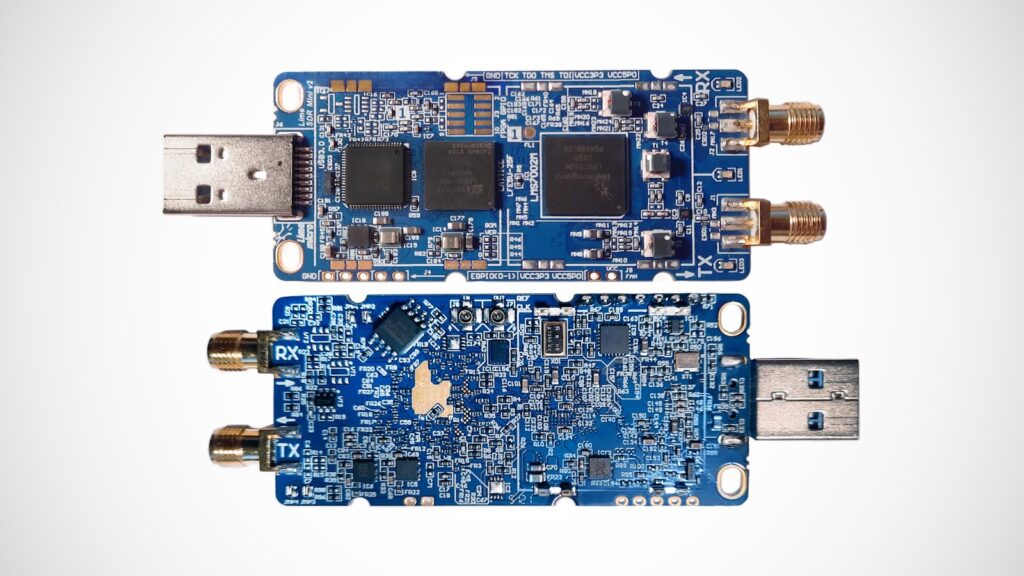LimeSDR Mini 1.0 End of Life, and LimeSDR Mini 2.0 to be Released
The LimeSDR Mini is a sub $200 RX and TX capable SDR with 12-bit ADC, 10 MHz to 3.5 GHz tuning range and up to 40 MHz of live bandwidth.
Due to supply chain difficulties sourcing the FPGA used on the LimeSDR Mini, an End of Life statement for the original LimeSDR Mini has now been released. However, the silver lining is that at the same time as this announcement Lime Microsystems have announced their plans to release the LimeSDR Mini 2.0.
Between the LimeSDR Mini 1.0 and the 2.0, there appear to be no major changes apart from the Intel Max 10 FPGA with 16k logic gates being replaced by the larger Lattice ECP5 FPGA with 44k logic gates. Lime Micro notes
Not only is the ECP5 more readily available than the Intel MAX10 FPGA used in the previous design, but it has an extensive set of open source tools and a great community of developers.
The LimeSDR Mini 2.0 is in currently the 'coming soon' status on CrowdSupply and you can subscribe there to get updates on when it is released.

if you plan to get a limesdr mini and have no special constraints (like too little space in your drawer or payload section of your 50kg drone), go for the normal/big one, it also has a better throughput (if i recall correctly)
the limesdr mini heats like a bitch, and not to risk overheating your half week’s earning before taxes you have to bodge on a diy cooler (and hope not to scrape/rip off any of the yordle-sized SMD components down the road), although two m.2 coolers placed Side To Side [Author’s Note: A New Season, Time To Shine] and “mounted” to the pcb with a thick thermal pad might work smoothly.
as for ready-made solutions which i initially searched for, a community-created “effective” (judging on the looks of somewhat direct-contact pads to the chips and actual fins, as opposed to the overpriced original one which cant even be ordered seperatly) cooling case, titled somewhat along the lines of “HACKERWARE LIMESDR MINI ALUMINIUM COOLER CASE” is available on CrowdSupply for the humble price of some 40 european shekels. but youre out of luck if you live in europe and dare to own no credit card.
Mouser(tm) redistributes some crowdsupply things, such as the limesdr itself, but (of course) not the HACKERMAN COOLER CASE as it is not RoHS compliant (though being completely made out of aluminium and a small, presumably cheap-chinese fan)
$79+shipping is not €40.
brandnew or secondhand limesdr mini wanted. if you have any idled, please contact me at [email protected].
I love the LimeSDR for satcom work. The previous comment about nose floor is unfounded in some applications. I am getting massive amounts of ACARS data from the Iridium constellation using the LimeSDR Mini. The RSP1a is crashing constantly, the Airspy Mini does not have enough bandwidth and the RTLSDR v3 covers far less than the required 10Mhz bandwidth.
Very much looking forward to a the LimeSDR 2.0.
Unfortunately, until LimeMS address the poor NF of this device, it’s of limited use compared to the other offerings in it’s price range.
At 433 MHz the LimeSDR mini has a NF of 13.8 dB and 15.8 dB at 1.28 GHz.
Whereas another well known device has a NF of just 2.5 dB at 433 MHz and just 5.4 dB at 1.28 GHz.
See Alexandru Csete and Sheila Christiansen’s marvelous analysis of the top seven devices aimed at the amateur market.
Picking one parameter and deciding that is the “important” parameter, is always a mistake. The radio that you are comparing it to only samples with 8-bits at 10MHz of bandwidth (due to USB 2.0 High Speed transfering data using isochronous mode), so it may have dynamic range issues if there is a strong signal near the wideband signal you wish to receive. It also only does RX (no TX capability). And if I wanted to use it with a RISC-V CPU I’m out of luck because the required binary blobs have not been created by the people who sell the hardware (yet) for say a “hifive-unmatched”. And if I was developing for anything other than Windows or Linux, e.g. *BSD – there are no binary blobs available. The LimeSDR-Mini 2.0 on the other hand is 100% open source, bill of materials, full schematic, ALL source code running in the SDR and on the host computer – if what I want does not exist I have access to all the knowledge required to make it happen myself.
Fair comment, but can you help me understand the following…
Whats wrong with picking one parameter if it’s crucially important ?
Sherwood Labs use close in dynamic range for it’s HF transceiver rankings.
What ‘mistake’ has Sherwood Labs been making in choosing that single parameter.
Above 1 GHz, NF is important, you know that.
As for hardware choices, I use the BladeRF 2.0 and the Pluto, they are both RX-TX.
Using SDRAngel and/or SDR++ with all these devices I can’t see any reason to follow the LimeMS roadmap.
Until they address their Noise figure issue…